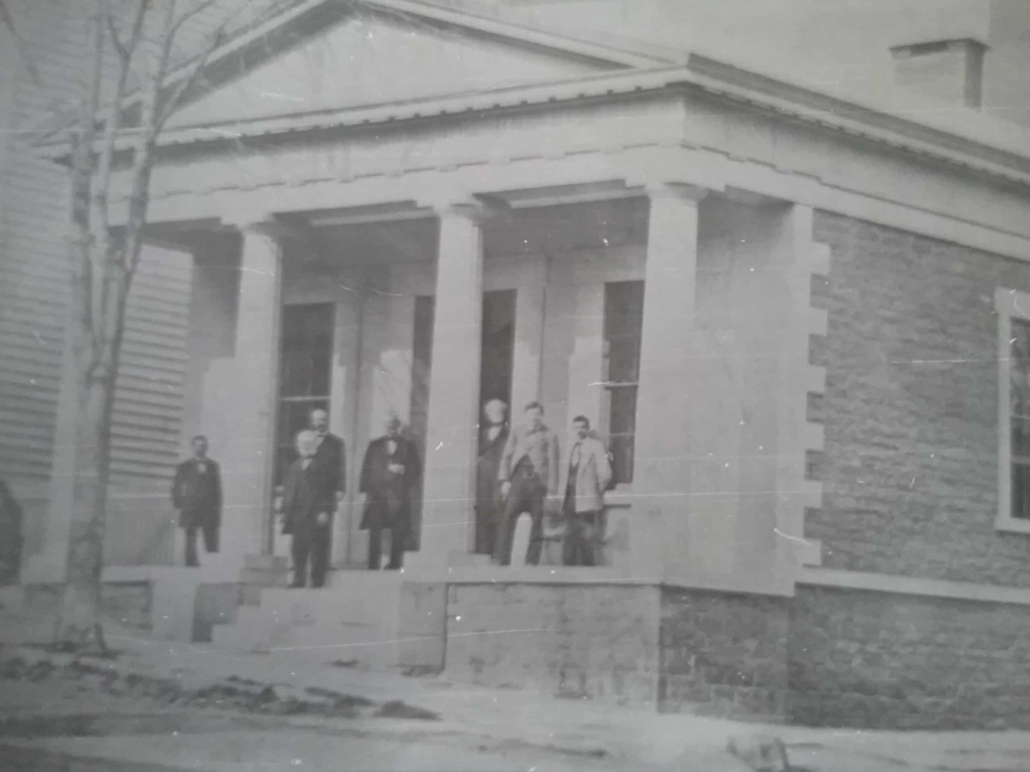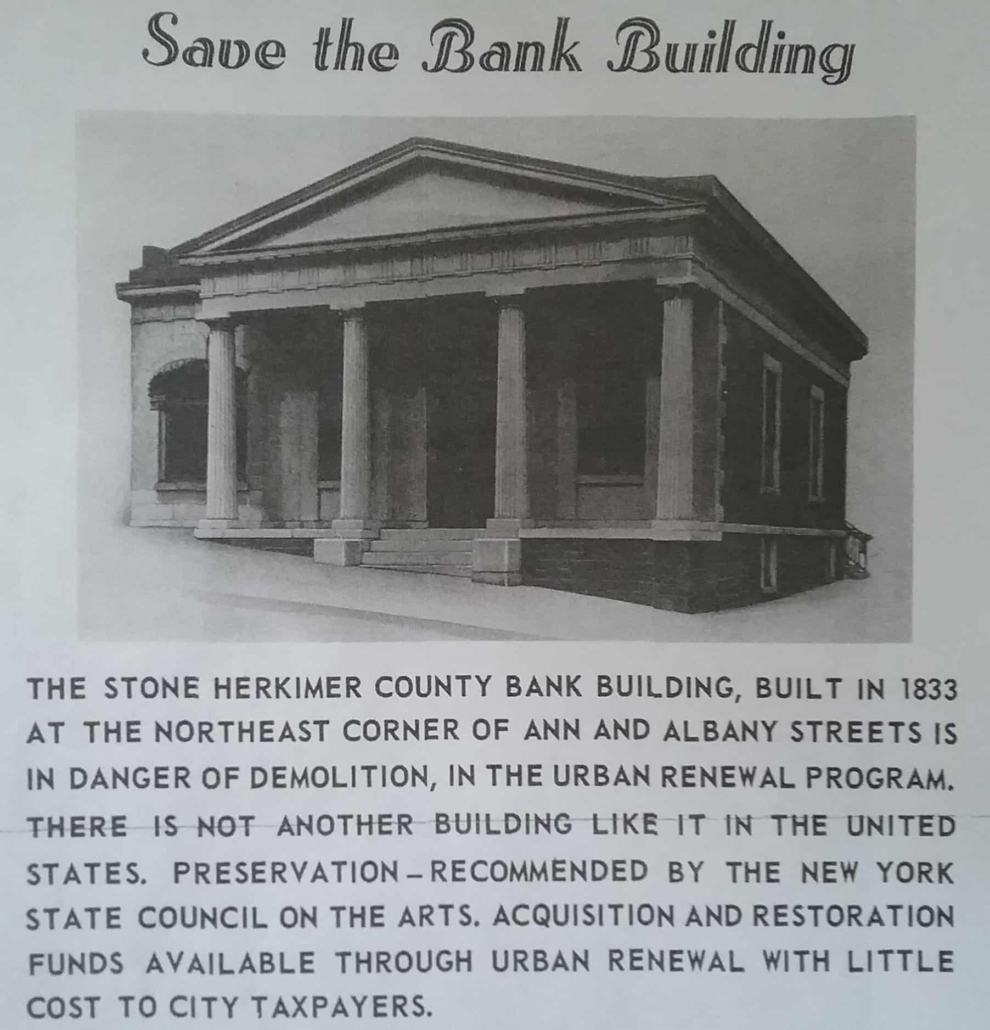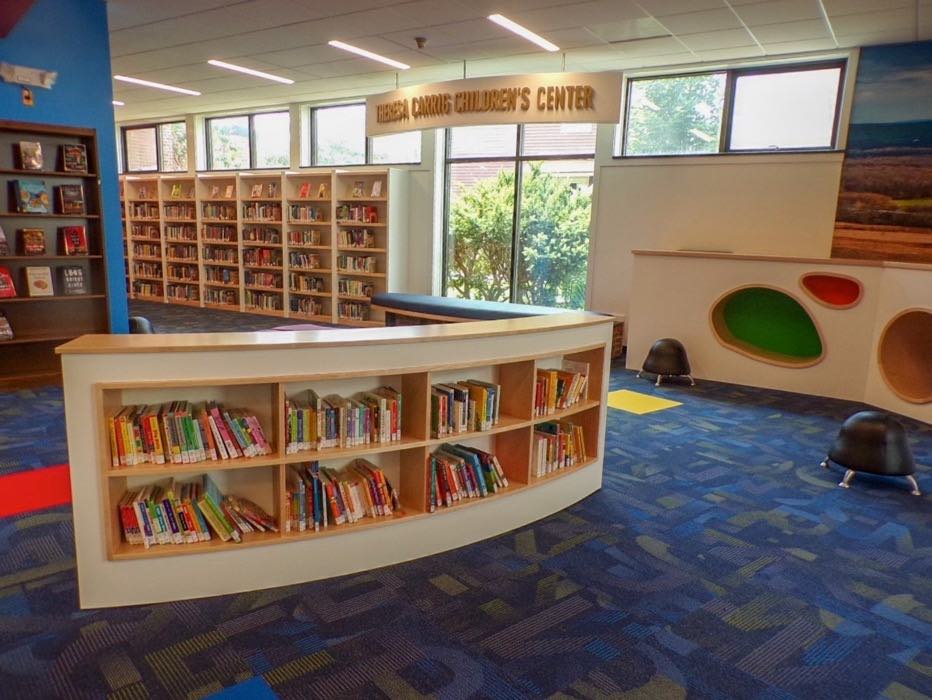THIS DAY IN HISTORY
Using a treasure trove at the Little Falls Historical Society Museum, Louie Baum toiled for months creating an over 200-page document to chronicle the historic past of Little Falls.
Using a treasure trove at the Little Falls Historical Society Museum, Louie Baum toiled for months creating an over 200-page document to chronicle the historic past of Little Falls.
Photo submitted – National Herkimer County Bank and Presbyterian Church in the background – (Kinney Plaza) circa 1860.
by Pat Frezza-Gressler, member of the Little Falls Historical Society
Constructed of native stone in 1833 as the first bank in Herkimer County and placed on the National Registry of Historic Places in 1970, the Little Falls Historical Society’s Old Bank Building Museum has had a storied past. 2020 marks the 50th anniversary of this designation and it is time to celebrate this great building as the survivor that it is!
The current generation of Old Bank Building Museum stewards stands on the shoulders of the small group of community visionaries who succeeded in their efforts to save the structure from the 1960’s urban renewal wrecking ball. Let’s begin by highlighting the chronology of important events related to this 1970 landmark designation.
Little Falls’ 1961 Sesquicentennial Celebration served as the catalyst for a small group of “history buffs” to secure a central location where important community artifacts would be permanently housed, displayed, and made available for research purposes. This group first met officially on November 29, 1962, and what would become our Historical Society was launched. Their headquarters was the GAR room upstairs in City Hall. In 1963 the Historical Society was granted a permanent charter by NYS.
By 1962, the Kennedy administration’s Urban Renewal program was in full swing; Little Falls received its first grant and demolition began on the south side of Main Street from Second Street eastward to William Street. A phase two grant was to be used to demolish the block of buildings between Ann and Second Streets, including the historic Old Bank Building. Historical Society president Dr. Fred Sabin first voiced the idea of saving the historic structure in 1965.
Of critical importance was the 1966 National Historic Preservation Act signed into law by President Lyndon Johnson. Lady Bird Johnson headed the commission which developed a national inventory of properties and buildings central to American character and identity. A mechanism had been created to protect such properties. What seems like commonsense today, historic preservation was at that time a radical idea “standing in the way of progress.”
Using this law as a guiding principle, the early members of the Historical Society stood four-square against the demolition of the Old Bank Building which upset many others, including the then-current administration. Old Bank Building demolition would allow for a larger parking lot for the new Herkimer County Trust building. The preserved need for fourteen extra parking spaces was pitted against the preservation of an important piece of community history.
This struggle played out for the next four years until the 1970 placement of the building on the NRHP; at that point, the structure was sacrosanct; some in the community were livid that a small group of “backward leaning preservationists” had stymied progress. Would anyone today trade the museum for those fourteen parking spaces?

To quote from a 1966 NYS Historic Trust newspaper article, “The old Herkimer County Bank Building, dating from 1833, is a work of the Greek Revival style, characteristic of the period. To discover a 130-year old bank is itself important, moreover, while much of the architecture of this period is constructed of wood, here we find a stone building with cut stone used in a monumental manner.”
Current Historical Society member Elaine Sperbeck remembers her father Harold being on the phone with the National Historic Preservation Commission in Washington making the case for Registry inclusion for the Old Bank Building. Using the Commission’s three criteria, Sperbeck reasoned that the building was associated with events significant to local history, that the building was associated with persons significant in local history, and that the building does embody distinctive characteristics of a type and period of architecture and construction.
The Old Bank Building met each of these criteria and on March 5, 1970, the structure was officially placed on the National Registry of Historic Places.

The Old Bank Building then sat in a sort of limbo and neglect from 1970 until 1977 when the Historical Society purchased the structure. Seven years of extensive restoration followed, and by 1985, Historical Society artifacts had been safely moved to the new museum.
The building that had served as the first bank in Herkimer County, as the office of the local Red Cross, as a mortuary, as a temporary location for the Little Falls National Bank, as the Railway Express office, and as a storage area for Lovenheim’s dry goods store had become the primary repository of local history.
Edward and Mary Louise Cooney, Natalie Derby, John Gallagher, John George, Mary Grace, Lydia Loucks, Robert McEvoy, Dr. Fred Sabin, Harold Sperbeck, and Ralph Van Horn.
Apologies if anyone involved in this effort was not included in this listing. Additionally, it is important to extend thanks to all those individuals, past and present, who followed in the footsteps of the above visionaries by their involvement and stewardship of the museum.
As Margaret Mead’s famous quote states: “Never doubt that a small group of thoughtful, committed citizens can change the world. Indeed, it is the only thing that ever has.”
Although the world certainly wasn’t changed, thanks to the efforts of the small group of committed citizens in saving the building from urban renewal, the Little Falls Historical Society remains an important community institution with plenty of parking nearby!
This article is more about the future than the past. Although 2020 will be remembered for the succession of crises that changed our lives in many ways, for the members of the Little Falls Historical Society, a group of six students from SUNY Oneonta’s Cooperstown Graduate Program of Museum Studies and their professor, this year will be cherished as the beginning of a successful collaboration.
The seed out of which this collaboration emerged dates back to mid-August 2018, when I newly arrived with my family to America in order to take up a teaching position at the science-track of the aforementioned program. Since Cooperstown was at the peak of its high season, our search for a temporary accommodation brought us to Little Falls.
During those two weeks, I discovered the perfect living example of what was taking shape as one of the main ideas with which I try to imbue my students: that even though our museum studies is unique in that it has a specific track on science museums, it is impossible to disentangle science, history and art into separate stories, since they are all intertwined.
This of course applies everywhere, but Little Falls exemplifies this in a particularly clear and explicit way – from its very existence due to the geological features of this part of the Mohawk River, through so many developments rooted in science and technology – the cheese market, engineering, the canals, the locks and the mill-powered industries and back to its geology as an attraction for tourism and leisure.
So, while I was still living in Little Falls, I brought my first cohort of science-track students on a field trip there. The experience was so well-received and enjoyed that in 2019 the field trip was expanded to include all students of the incoming cohort, in both the science and history tracks. As in 2018, we made sure we visited the Little Falls Historical Society Museum, and we were once again given the warmest welcome by the docents on duty that day.
While the students were exploring on their own, my mind wandered to one of the new courses I was going to introduce for the 2019-20 academic year: it was going to be a course in which this idea of multidisciplinarity would be revisited and taken to the next level, a capstone course in which the science-track students and possibly history-track students would put into practice much of what they learned in earlier courses.
Although I had not yet found how exactly this would be done, I was certain that Little Falls and its Historical Society would play an essential role. So, I left my business card at the museum with the message that if anyone was interested in taking up the idea of exploring a potential collaboration, I would be happy to get in touch.
Just a few days passed until the phone rang, with Jeff Gressler on the line, conveying not only the interest of the Society’s board of directors with this idea, but also a very warm, friendly and heartfelt passion and energy that set everything in motion. The collaboration began with a couple of mutual visits, meeting the students who would take the course and who themselves helped us brainstorm ideas. The course was named “A Science Cabinet of Curiosities” and every year its students will be given a time period for which to pick an object each from the collection at the Little Falls Historical Society Museum and work on communicating to the public its connection to Little Falls history. The actual format of this “cabinet of curiosities” will vary every year, for 2020 it was decided it would be as a book which is currently in the making.
Student topics chosen and completed in 2020 included: the 1833 Old Bank Museum building that houses the Little Falls Historical Society, the 1940 Gulf Curve train crash, the history of canals and canal construction through Little Falls, the discovery of rennet and its impact on cheese manufacturing, Little Falls / Herkimer diamonds, and the history of factories and labor unrest in Little Falls.
Just as every good story, this one ends where it began, because the science-track students who have just completed this course are the same students who came to that first field trip when I had just discovered the educational value of a visit to Little Falls. By now I have discovered much more, I have also discovered some of the wonderful people who inhabit this town, who bring to life the Little Falls Historical Society and who make working together such a memorable experience for the students and me. The experience has certainly been enriching, productive and even mutually beneficial – but most of all, it has been the expression of a heartfelt friendship that outshines the backdrop of calamities that we have endured in 2020.
Little Falls native Blaise Carrig (LFHS class of 1969) and his wife Leslie donated $50,000 earlier this year to six Little Falls non-profit organizations. The Carrigs responded to a series of questions for this article from their home in Longmont, Colorado.
“We make a living by what we get but we make a life by what we give.”
Winston Churchill
RESPONSE: We have been particularly inspired by the philanthropic efforts of people like Bill and Melinda Gates. We are fortunate to be able to be generous. Our primary goals are to help kids and families in need and to get kids outdoors to enjoy the natural world. For our giving to Little Falls entities, we have taken a broader view, encompassing some of the cultural and economic efforts taking place.
RESPONSE: We feel fortunate and grateful for the ability to give back. Organizations that positively affect the lives of families in need are worthy of financial assistance. Little Falls has a number of such organizations and people doing great things.
RESPONSE: This was not an easy decision for us. While we often prefer to remain anonymous with our charitable donations, our primary goal in “going public” this time is to hopefully inspire other Little Falls residents and expatriates to support these worthy non-profits that are doing so much. I follow the My Little Falls online newsletter that Dave Warner publishes; I was struck by an article about the Community Chest having difficulty meeting their annual fund-raising goal. I see a lot of people on the I Remember Little Falls Facebook page who talk lovingly about their hometown, we hope to inspire some of those folks to consider giving back, even small amounts can greatly help these non-profits
RESPONSE: I feel very fortunate to have grown up in Little Falls and have great memories, appreciation, and fondness for my hometown. Additionally, a number of friends that I grew up with in Little Falls regularly donate much of their time and energy to the organizations that we donated to. Their efforts inspired us.
RESPONSE: Little Falls is a special place. When visiting family and friends, we are struck by the city’s timeless beauty and the volunteer energy that enhance the quality of life there.
Blaise also added that his parents loved Little Falls and the amenities and quality of life that exist here. Indirectly, Tom and Theresa Carrig were the inspiration for their son’s and daughter-in- law’s generous gift to Little Falls non-profits.
Once the COVID-19 health crisis subsides, we all hope that Blaise and Leslie continue to visit Little Falls. On behalf of our entire community, the Little Falls Historical Society wishes to thank them for their inspirational generosity.

This new page is for the purpose of collecting residents’ input and creating a body of work that will help future generations better understand how the greater Little Falls community has been impacted by the pandemic.
Society members, local students and all other community residents are invited to submit written work, art work or photographs by using the submission form on the Making History Today page.
Submission guidelines and parameters are displayed on the Making History Today page.
All of the published articles can be read on both the Times Telegram and our website. We hope you enjoy the series!
To help support NYS and US efforts to contain the spread of COVID-19 and to protect the health of our visitors and staff, the Little Falls Historical Society Museum is temporarily closed to the public until it is safe to reopen. We will continue to monitor the situation closely and look forward to resuming operation whenever possible. We will continue to follow guidelines from the Center for Disease Control, Governor’s Office, and federal government. Check back here for updates.
Our 2020 Writing Series began in April and will continue to be published in the Times Telegram and on our website. Please continue to stay safe and well. Inquiries can still be sent here.
On Saturday, March 7, 2020, the Herkimer Times Telegram published an article, “Studying pieces of history” featuring the collaborative project between Little Falls Historical Society Museum and SUNY Oneonta second-year graduate students as they study Little Falls’ historic industrial period from 1790-1960. Use this link to view the article in its entirety or https://herkimertelegram-ny.newsmemory.com/?publink=158cc708e_1343597.
The Little Falls Historical Society recently began a collaborative partnership with SUNY Oneonta’s Cooperstown Graduate Program of museum studies for the 2020 spring semester.
Dr. Erik Stengler’s second year graduate students will study Little Falls’ industrial history from 1790 – 1960 to fulfill requirements for the program’s Science of Cabinet Curiosities course. Upon successful completion of the spring semester, these Cooperstown students will have earned their graduate degrees in museum studies from SUNY Oneonta.
This is a hands-on course requiring students to deploy skills and learning from past coursework and apply them to a specific research project. The partnership’s primary purpose is to provide students with a real-world museum experience.
Students are required to select one object from the collections of the Historical Society’s Old Bank Museum and carry out in-depth research about how that object relates to a theme set at the beginning of the course.
The final course outcome will be an exhibition that brings all the student objects together into a book that collectively communicates their significance. Each student will contribute about ten pages to this book.
A core group of Historical Society volunteers has worked closely with Dr. Stengler in establishing both the working partnership itself and specific course requirements. Program students have worked on-site at the Old Bank Museum on a number of occasions.
For more information, go to: http://cgpmuseumstudies.org OR https://www.facebook.com/CGPScience/.
The Historical Society’s nominating committee has submitted a slate of candidates for all four officer positions and for the two board seats with expiring terms. Society members can also nominate additional candidates from the floor prior to elections.
Following the completion of elections, Historical Society member Mike Potter will display and narrate a number of historic pictures from a bygone era in Little Falls.
Light refreshments will follow Potter’s presentation. All Historical Society meetings and presentations are free and open to the public.
